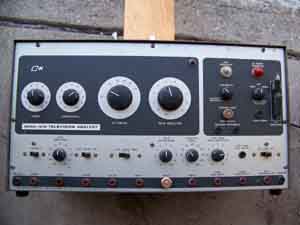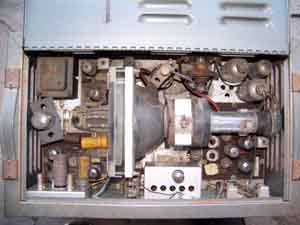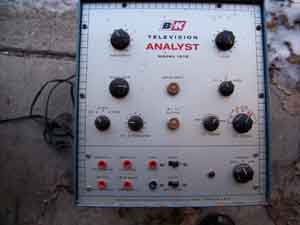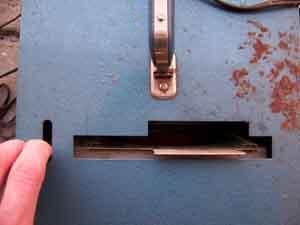 B&K model 1076 TV Analyst, front panel
B&K model 1076 TV Analyst, front panel
 B&K model 1076 TV Analyst, top of chassis. Transparency slides between CRT, center and PMT at left-center.
B&K model 1076 TV Analyst, top of chassis. Transparency slides between CRT, center and PMT at left-center.
 B&K model 1075 TV Analyst, front panel
B&K model 1075 TV Analyst, front panel
 B&K model 1075 TV Analyst, top view. Release spring-driven lever. Drop transparency in slot.
B&K model 1075 TV Analyst, top view. Release spring-driven lever. Drop transparency in slot.
|

Television AnalystService scanner. When most television techs think "flying spot scanner," one product leaps into their minds: The Television Analyst. For years, the great manufacturer B&K sold its FSS to TV service shops. B&K's Television Analyst models 1075, 1076 and 1077 contain a CRT-based scanner and a photomultiplier (PMT) pickup tube. The 1076 contains 16 tubes, including a PMT and a five-inch CRT. Probably the most famous of the TV Analyst scanners is the 1077B. To use the Analyst, you slide a transparency over the CRT face. This transparency could be a standard test pattern or any piece of flat, transparent art. The Analyst accepts media that are several inches across. The Analyst's dedicated, short-persistence CRT scans the transparency onto a 931A PMT. In at least some models, the CRT scans with ultraviolet light. (The 1076 and 1077B are among these models.) Since the photomultiplier tube is particularly sensitive to ultraviolet, the CRT is a perfect match for the PMT. The dot size is very small, and the scans are very sharp. Unlike the Televerter, the Analyst requires no optics between the CRT and PMT. The Analyst's circuitry amplifies the video and transmits the signal on any VHF or UHF channel. (UHF channel options include obsolete, high-band channels up to Channel 83.) A standard, analog TV set can pick up telecasts from the Analyst's RF modulator.Technicians use the Television Analyst to test and align color or black-and-white TV circuits. An Analyst can test and troubleshoot just about any circuit in a television set. This unit can inject a signal to replace a defective one. You can also use the Analyst to test flyback transformers. What the Analyst is, then, is a TV station in a 30-pound breadbox. Yet like von Ardenne's invention, the Analyst is itself a type of TV set: A TV set that watches. DuMont Vitascan®A flying-spot studio. Von Ardenne's invention is an electronic version of scanners that made mechanical television possible. For many years, flying-spot scanners found commercial uses in electronic TV studios, too. Some film chains use FSS technology. In the 1950s, Allen DuMont designed Vitascan®, an entire TV news studio. In DuMont's Vitascan® studio color scanners replace the cameras. DuMont's news anchors and reporters read the news in semi-darkness. On their news set, raster generators scan the talent from the usual camera positions. Instead of the normal studio floodlamps, photomultipliers occupy the scoops in the ceiling. During the vertical blanking period, strobe lamps provide reading light. The rest of the time, the studio is dark. This darkness allows studio scanners to operate without interference. The Vitascan® idea works well, but is impractical for outdoor use. See... Vitascan |
Mechanical Flying Spot Scanners
In natural light. Outdoor scanning challenged flying spot scanners of the mechanical TV era, too. Most of these scanners descended from Frank Gray's 1925 model. Gray designed his scanner for Herbert Ives' team at AT&T.
In those days, thousands of people built TV receivers from kits or radio magazine plans. At a reasonable frame rate, the AM radio band limits picture resolution to about 24 lines. (By a reasonable rate, we mean some 15 frames per second.) While such pictures are sketchy, they provided early adopters with an enormous thrill.
In 1928, then New York Governor Al Smith was going to announce his run as Democratic presidential candidate. He was to make his speech from the New York Capitol steps in Albany. For one of the first television actualities, Ernst Alexanderson's 24-line GE scanner made the scene. AM radio station WGY would broadcast the live pictures to its regular radio audience.
GE and WGY's dress rehearsal came off without a hitch. Alexanderson's scanner provided just enough light to overcome the sunlight and produce finely-detailed images. Inside the scanner was a thousand-watt lamp. A large disc scanned this lamp to produce a raster. A lens projected the raster on the speaker's podium. On tripods, two photoelectric cell banks picked up rasterized images. Despite the sun, the pictures were splendid. But then, candidate Smith showed up, and along came an entourage of newsreel cameras. The movie klieg lights fired up and blinded GE's scanners. For GE, the show was over.
Ray Kell operated GE's ill-fated Albany scanner. Alda Bedford watched the monitor 18 miles away. He also transmitted Kell's pictures out over WGY. A few years later, RCA took over both the GE and Westinghouse television research efforts. At that time, Kell and Bedford became RCA talent.
More About the Inventors
Ray Kell. We also know Ray Kell for his 1934 discovery of the Kell Factor. The Kell Factor predicts the effective resolution of a scanned picture display. Due to losses in the scanning process, the effective resolution is only a fraction of the mathematical resolution. A typical Kell Factor for CRTs is about 67 percent. (Sometimes greater.) LCD displays have a higher Kell Factor. Kell went on to manage RCA's famous color television development efforts. In December 1953, these efforts produced the official US color TV system.
Alda Bedford proved that the human visual system can't distinguish colors in small areas. This discovery resulted in RCA's invention of "mixed highs" television systems. These systems reduced the color bandwidth without noticeably decreasing quality. Here's how "mixed highs" work: In television, high frequencies convey small picture details. The transmitter sends small details, that is, high frequencies, in monochrome. The color signals only include the low frequencies. Bedford also invented the color burst, a method of synchronizing television's color section. Without these ideas, analog color television as we know it wouldn't be possible.
Frank Gray invented the Gray Code. Use of this code prevents errors in rotary position sensors. The Gray Code is helpful in genetic algorithms. Genetic algorithms evolve and test code or circuits until they solve a particular problem. Just like biological evolution, the process includes DNA, mutation and natural selection. Only the fittest code or circuit survives. We also use the Gray Code to prevent errors in analog-to-digital conversions.
Go to Page: 1 2 Back